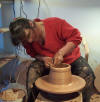

Every wheel thrown pot comes from a cylinder. Vases are tall thin ones and plates are short fat ones but they all begin as a cylinder.
The cylinder is drawn to the desired height and then shaping begins.Cindy demonstrates throwing a dinner plate with the perfect profile rib.

(Click for a larger image)
Here Cindy is throwing a large bowl.
Excess water is removed from the bowl with a sponge which also
smoothes the
surface and contributes to the strength
of the finished bowl when it is in your kitchen environment.
The freshly thrown bowl is then removed from the wheel and allowed to dry to a
"leather hard" state
at which point it can be trimmed to remove excess clay from the bottom and establish a foot.
(Click for a larger image)
Another method of throwing bowls is "Throwing off the Hump".
Cindy demonstrates trimming a bowl on the wheel.
Once the pot is trimmed it is again set on the shelf to dry. This will take several days for a bowl this size
as the drying rate must be carefully controlled to prevent cracking. We have found these bakers racks are
ideal for drying as they allow a uniform air flow around the pieces.
Plastic sheets enclose the shelves and are adjusted to control the drying rate.
(Click for a larger image)